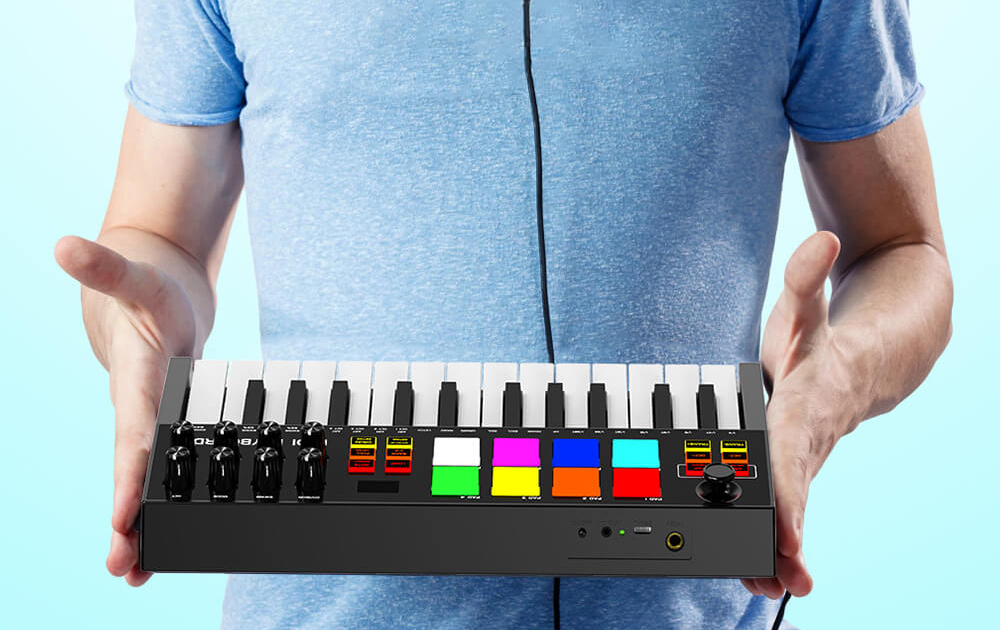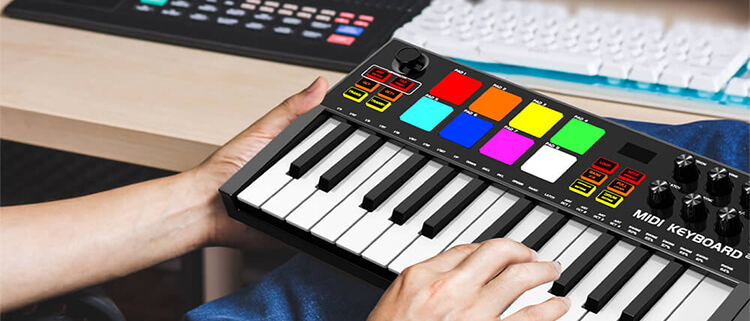What is a MIDI Controller Keyboard? A Look at the Konix MIDI Controller Keyboard
In the world of music production and performance, a MIDI controller keyboard has become an essential tool for musicians, producers, and composers. Whether you’re working in a studio, performing live, or experimenting with electronic music, a MIDI controller can unlock new creative possibilities. The Konix MIDI Controller Keyboard, a product designed with both professional musicians and beginners in mind, represents the next generation of digital music-making technology.
But what exactly is a MIDI controller keyboard, and how can it be used? Let’s explore its functions and capabilities, using the Konix MIDI Controller Keyboard as an example.
What is MIDI?
Before diving into the specifics of a MIDI controller keyboard, it’s important to understand MIDI (Musical Instrument Digital Interface). MIDI is a digital communication protocol that allows electronic musical instruments, computers, and other devices to communicate with each other. Instead of sending audio signals, MIDI sends data about musical performance, such as which notes are being played, how long they are held, how loud the notes are, and the effects applied to them. This data can be interpreted by any compatible MIDI device, such as a synthesizer, computer software, or sound module, and turned into sound.
A MIDI controller keyboard does not generate sound on its own. Instead, it sends MIDI data to another device, such as a computer, sound module, or synthesizer, which then produces the actual sound. It is essentially a digital interface for controlling virtual instruments or other MIDI-compatible hardware.

Features of the Konix MIDI Controller Keyboard
The Konix MIDI Controller Keyboard is packed with features that cater to musicians of all skill levels. Here are some of the key features that make it a powerful tool for music production and performance:
1. Velocity-Sensitive Keys
One of the defining features of the Konix MIDI Controller Keyboard is its velocity-sensitive keys. This means the keyboard responds to how hard or soft you press each key, just like an acoustic piano. By varying the pressure you apply to the keys, you can create more dynamic performances, with softer or louder notes. This sensitivity allows musicians to have full control over the expressiveness of their music, whether they’re playing classical, jazz, or electronic styles.
2. Assignable Controls
The Konix MIDI controller comes equipped with knobs, sliders, and buttons that can be customized to control various aspects of your music production environment. These controls can be mapped to manipulate parameters in your digital audio workstation (DAW), such as volume, pan, filters, or effects. This hands-on control provides a more tactile and intuitive way to adjust settings while producing music, especially when compared to relying solely on a mouse or keyboard.
3. Octave Shift and Pitch Bend
The keyboard includes octave shift and pitch bend functions, giving musicians more flexibility in their performances. The octave shift buttons allow you to shift the range of the keyboard up or down, making it easier to play melodies or bass lines that are out of reach of the standard keyboard range. The pitch bend wheel allows you to manipulate the pitch of the notes in real-time, adding expressiveness similar to the bending of guitar strings or the vibrato on a violin.
4. Compatibility with Software and Hardware
The Konix MIDI controller keyboard is designed to be highly compatible with a wide range of software and hardware. Whether you are using Ableton Live, Logic Pro, FL Studio, or other popular DAWs, the Konix keyboard will integrate seamlessly into your setup. It also works with hardware synthesizers, sound modules, and samplers, making it a versatile choice for both studio and live applications.
5. Portable and Lightweight Design
The Konix MIDI Controller Keyboard is designed to be portable and lightweight, making it perfect for musicians who need to transport their setup to different locations. Despite its compact size, it does not compromise on key quality or functionality. This makes it ideal for musicians on the go, whether they’re playing live shows, recording demos, or simply rehearsing at home.
6. Built-in Arpeggiator and Pads
Some models of the Konix MIDI controller keyboard come equipped with a built-in arpeggiator—a tool that automatically plays a sequence of notes in a specific pattern, creating rhythmic and melodic effects. In addition, performance pads provide a convenient way to trigger drum sounds, samples, or loops, making it easier to create beats or trigger sounds during live performances.

How is a MIDI Controller Keyboard Used?
The Konix MIDI controller keyboard can be used in various ways depending on the musician’s needs, but some common uses include:
1. Music Production in the Studio
The primary use of a MIDI controller keyboard is for music production. When connected to a computer and a DAW, the MIDI controller allows the musician to control virtual instruments, synthesize sounds, and input musical compositions. Using the keyboard’s velocity-sensitive keys, knobs, and buttons, a producer can write and edit MIDI notes, control volume and effects, and automate changes throughout a project. It is an essential tool for composers who create music electronically, and it opens up a world of possibilities for sound design.
2. Live Performances
MIDI controllers are often used in live settings, especially within electronic music genres, where DJs, producers, and performers use them to trigger sounds and effects in real-time. The Konix MIDI controller keyboard’s pads and assignable controls allow musicians to manipulate loops, samples, and other elements during their performances, providing an interactive experience for their audience.
3. Education and Practice
For beginners, the Konix MIDI controller keyboard can serve as a great tool for learning music. By connecting it to software with educational tools, users can practice playing along with digital pianos, synthesizers, and other instruments. The MIDI functionality allows beginners to see and hear their progress as they learn different scales, chords, and techniques. It is also a fantastic option for those who want to experiment with music without having to purchase expensive physical instruments.
Advantages of Using a MIDI Controller Keyboard
- Versatility: A MIDI controller keyboard can be used to control an almost unlimited range of sounds, from piano to orchestral strings to electronic synths.
- Portability: The Konix MIDI controller is lightweight and compact, making it easy to take to gigs, rehearsals, or on the road.
- Hands-on Control: The combination of keys, knobs, sliders, and pads offers tactile control over your music, allowing for more dynamic and expressive performances.
- Cost-Effective: A MIDI controller provides the functionality of a full range of virtual instruments at a fraction of the cost of buying individual hardware synthesizers or other instruments.
Conclusion
The Konix MIDI Controller Keyboard offers musicians and producers an intuitive, flexible, and portable tool for creating music, whether in the studio or on stage. With its comprehensive features like velocity-sensitive keys, assignable controls, and compatibility with DAWs, it’s a perfect choice for anyone looking to enhance their musical creativity. Whether you are a seasoned professional or a beginner, a MIDI controller keyboard like the Konix model can greatly expand your musical horizons, giving you greater control, expression, and freedom in your music production.





